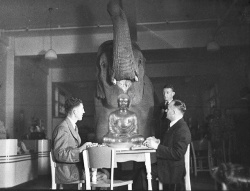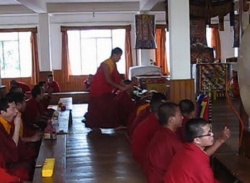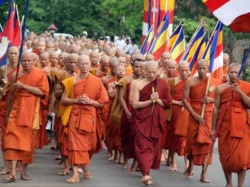The Nine Ways
Teachings by H.H. Dilgo Khyentse
H.H. Dilgo Khyentse Rinpoche (1910 – 1991) was one of the greatest teachers of the 20th century. Karma Thinley Rinpoche was one of his close disciples and received the Rinchen Terdzod from him. Lama Jampa Thaye received much dzok chen teaching from him in private in 1976 including Patrul Rinpoche’s ‘Hitting at the Essence in Three Words’.
His Holiness gave the following teaching, translated by Tulku Pema Wangyal, on the Nine Yanas – Nine Ways – of the Nyingma tradition at KagyuLing in Manchester on February 24th 1976. The Nine Yanas embody the ascending sequence to be followed by the practitioner in developing the view, meditation and activity that will lead to Buddhahood.
The First Yana
The first yana is known as the sravakayana. Now each yana comprises view, meditation and activity. In the sravaka view, the individual is seen as void, however all other phenomena are seen as substantial entities. The essential voidness of all phenomena is therefore not realized. Here, the main object of meditation is the Four Noble Truths, which are:
1. That we experience suffering.
2. That selfishness is the cause of suffering.
3. That the cessation of suffering is attained through the renunciation of selfishness.
4. That the Path provides the means to achieve this goal.
The activity of the sravaka is to take vows as an upasaka, sramanera or bhiksu (lay, novice, monk) and to maintain the disciplines which accompany these vows throughout one’s life.
The Second Yana
The second yana is known as the pratyekabuddhayana. The view is the same as that contained in the first yana. However, here, the view of the insubstantiality of self is fully realized through meditation on the pratityasamutpada (‘dependent origination’). The pratyekabuddha meditates both clockwise and anti-clockwise on the 12 interdependent links: from unawareness to death and back again in reverse order. Through this practice, he develops a certain degree of samatha (calm) and vipasyana (insight). A teacher must be found who will give the initial teachings; however, subsequent to this, the pratyekabuddha level is attained through one’s own experience. The activity of the pratyekabuddha is the same as that of the sravaka.
The Third Yana
The third yana is known as the bodhisattva way. The motivation of the bodhisattva is different from that in the previous two yanas. Whereas there one was concerned with oneself, and with escaping from the suffering of this world, here, in the bodhisattvayana, the concern is directed towards the suffering of others as well. During meditation, or before meditation, one thinks of others. One tries to attain the removal of the suffering of all sentient beings, and one never thinks only of oneself. In the view of the previous two ways, only the individual self is seen as void, and thus the sunyata nature of all phenomena is only partially realized. However, the aim of the bodhisattvayana is the realization of the sunyata nature of both subject and object, through meditation upon compassion and sunyata. The activity of the bodhisattva is the practice of the six perfections.
There are two basic differences in the teaching of the Buddha: sutra and tantra. Tantra is divided into different levels. There are two main divisions: external and internal tantra. External tantra comprises three different categories of tantra and tantric practices.
The Fourth Yana
The first tantric practice, or the fourth yana , is known as the kriyayana. Prior to beginning this practice, one must have received the empowerments (abhisekas). Great importance is placed on the guru here, and everything must be received through one’s own guru. The empowerments one receives before commencing kriyayana meditation are twofold: the vase and the crown empowerments. Whereas in the meditation of the lower ways, there are not many visualizations involved, here there are many. One meditates on certain forms of the Buddha and on three different deities: Avalokitesvara (compassionate nature of the Buddha), Manjusri, and Vajrapani, The view here is, again, the realization of the sunyata nature of all phenomena. The manner in which we meditate upon the deity differs from that of the higher tantric yanas. In the kriyayana, the deity is seen as superior to oneself. The deity can be seen as a king and oneself as subject, since one has to receive orders and blessings from the deity. Through this practice, one can accomplish realization in 16 lifetimes. In the kriya tantra much importance is placed on habits such as diet. For instance, one may eat vegetarian food, avoiding meat. Emphasis is also placed on cleanliness, bathing, and changing one’s clothes frequently. This is the activity of kriya tantra.
The Fifth Yana
The second tantric practice, or the fifth yana , is known as the upayana. In order to undertake this, one has to receive five different empowerments, and the attitude with which one views the deity differs from that of the previous kriya tantra. Here, the deity is seen as a brother, not as a king. Less emphasis is placed upon habits of cleanliness and diet, although these can be used as aids to develop practice. The upayana can bring realization in six lifetimes.
The Sixth Yana
The third tantric practice, or the sixth yana , is known as the yogayana. In order to undertake this, one has to receive the above five empowerments as well as the vajracarya empowerment. Here the deity is seen to be identical with oneself. The yogayana view is the unity of sunyata and compassion. Realization can be attained within three lifetimes.
The Seventh Yana
The first internal tantric practice, or the seventh yana , is known as the mahayoga meditation. One must have received four empowerments: the vase, the secret, the prajna-jnana and the absolute empowerments. Through this practice, realization can be attained within one lifetime.
The Eighth Yana
The second internal tantric practice, or the eighth yana , is known as the anuyogayana. As in the mahayogayana, many visualizations are involved. Here we have the two basic categories of vajrayana practice: the developing stage and the perfecting stage. Whereas in the mahayogayana the developing stage was emphasised, here, in the anuyogayana, more emphasis is placed on the perfecting stage. Now, in anuyoga meditation, one concentrates on the second and third empowerments and their related practices, such as the six yogas of Naropa. Through this practice, realization can be attained in this very lifetime.
The Ninth Yana
The ninth yana is known as the atiyana, the most supreme yana. In order to begin this meditation, one has to receive the ultimate empowerment, known as the awareness empowerment, which is the direct transmission of the power of awareness. One has to develop the two different practices known as trecho and togal. In togal, the lama introduces one to one’s own nature and one immediately accomplishes realization. The togal method is for those who have reached a very high level of understanding either through past lives of practice, or through having practised trecho for a long time. If one has not reached this level, one can practise trecho, and realization can be attained within three to twelve years. This yana is far superior to the lower yanas and is therefore known as the primordial and highest teaching of the Buddha.



